Marks of Transformation:
Tribal Tattooing in California and the American Southwest
Article © 2010 Lars Krutak
Tattoo “Doctors”
Mohave warriors frequently had a large circle (or two smaller ones) tattooed on the chest with one or two lines radiating toward the shoulders. Other important men, like scalp-keepers, wore a T-shaped design on both sides of their face just below the cheek-bone.
Like the Mohave, Nomlaki (Central Wintun) tattooists were specialists. Nomlaki informants interviewed about 1900 specifically stated that the ability was obtained through the Huta, a men’s secret society. The initiation was viewed as an experience through which youths acquired the ability to engage in a professional or special craft, and a prevailing attitude regarded that the ability was a special talent that presumably rested on a spiritual base.
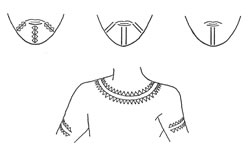 |
|
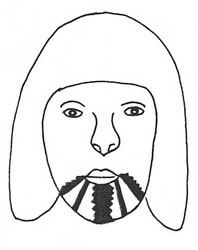 |
Nomlaki. Facial styles of women & tattooed “necklaces” of men, 1900. |
Wintun. Trinity River Wintun women wore much heavier facial tattoos than their Chimariko and Hupa neighbors. The entire cheek up to the temples was tattooed as well as the chin, and burnt wormwood has been documented as the traditional pigment. The tattooing was restricted to the women alone, and was effected by the same method as among the Shasta and Hupa, namely by fine parallel cuts with obsidian or chert lancets rather than by puncture. The process was begun early in life, and the lines broadened by additions from time to time, until in some cases the chin became an almost solid area of blue. Certain women were considered experts in creating these marks, and were in much demand.
The Wintun, and presumably other groups, also practiced medicinal forms of tattooing that were employed for the relief of rheumatic and chronic pains. Both men and women utilized this therapy, and in such cases the tattooing was placed directly over the painful spot. |
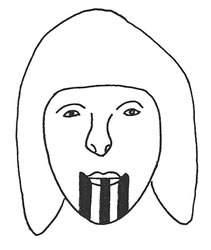 |
| Shasta. Tattoo designs of a Shasta woman, 1900. |
|
|
Women were strictly excluded from all of the proceedings, and it is clear that there was no public announcement of what was to take place. Some elders stated that the rite took place in the spring and was typically held in conjunction with the construction of a new sweat house.
Members of the Huta called each other “brother,” and if a member was found to have divulged any of the esoteric knowledge associated with it to an outsider, he would be hunted down and killed. Informants stated that hired assassins among the Shasta were employed for this purpose. |
The practice of tattooing was called dopna or topa meaning “to cut.” A flint knife was used to make the necessary incisions and soot from charred oak galls was rubbed into the cuts. The age for tattooing girls was between twelve and fourteen, but there is little indication that it was connected with their puberty ceremony.
| 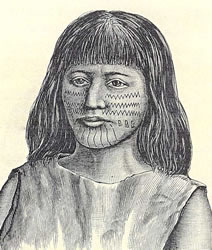
|
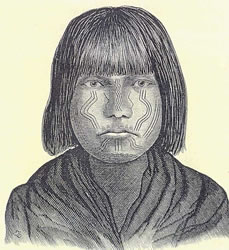 |
Wailaki. Woman with facial tattooing, ca. 1870. |
Yuki. Facial tattooing, ca. 1870. |
The most frequent Nomlaki design was three serrated lines from the lower lip to the chin that was worn by both men and women. The northernmost Wintun tattooed a double line from the lip to the chin on women, and three double lines on the chin.
Not every village had a tattooist, and frequently individuals had to travel to a distant settlement and pay for the operation. It is said that the Wintun considered their tattoos to be the best. “The Yuki and Wailaki have funny patterns – they just spoil their faces by making the whole face look black.”
Next Page |
1
|
2 |
3 |
4 |
5 |
6 |
7 |
Museum photo gallery of the images
on this page may be seen here. |





